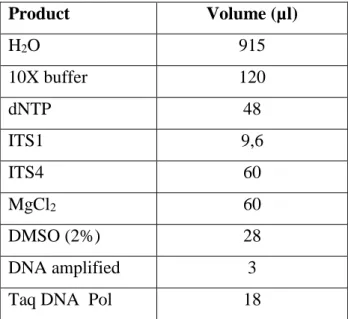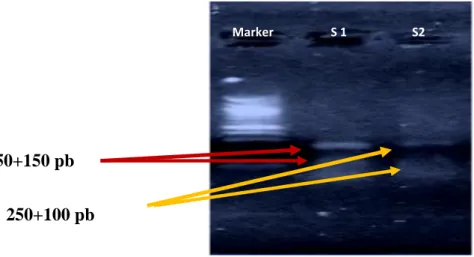MICROBIOLOGICAL, BIOCHEMICAL AND MOLECULAR
IDENTIFICATION (PCR-RFLP-ITS) OF THE YEAST FROM
SULTANA GRAPE CULTIVATED IN AIN MERANE
(WILAYA OF CHLEF)
Asmaa BOUKHENNOUFA1*, Nadia BERBER1, RachidAISSAOUI2, Ahmed MhamedBenaliBEKADA1
1Microbiology Laboratory, University of AbdelhamidIBN BADIS, Mostaganem, ALGERIA 2Bioconversion Laboratory; University of Mustapha STAMBOULI, Mascara, ALGERIA
Current Research on Biological Sciences
(CRBS)
Abstract:
Grapes defined as the fruit of the vine, the most cultivated in the world. It is considered a major habitat of many yeast species. This work aims to isolate, purify and characterize species of yeast from the sultana grape (Thompson’s seedless)cultivated in the region of Ain Merane (from Chlef, Algeria). Several tests were performed (microbiological and molecular).Two strains isolated from grape juice obtained by simple grinding.Pichia fermentans and Metschnikowia pulcherrima were confirmed by a genetic approach (ITS-RFLP) using two restriction enzymes (Taq I, and HaeIII), of the region (ITSI, 5.8S rRNA, ITSI) amplified by PCR.
Keywords: Grape, Sultana (Thompson's seedless), Taq I, HaeIII, PCR, ITS rDNA.
1. Introduction :
Sultana (Thompson Seedless) plays a leading role as grape drying.It is characterized by the practical absence of seeds,rich in sucrose,ease of drying, and it is grown in regions marked in winter and dry summer (Levadouxet al., 1971). Its considerable economic importance is at the level of fruit production. Its large sugar content promotes the growth of yeast, which is considered animal food. The producing yeast extracts was used as nutrients or flavoring agents in food. In addition, most recently yeast is used as probiotics. It is since ancient times, at the base of the bread and manufacture of alcoholic beverages. In addition, today it continues to be indispensable for these industrial activities (Larpent, 1991). This may be added the production of biofuels such as ethanol.It is in this context that fits the purpose of this study, in the laboratory of Algeria. At the end of installing a clean bank yeast species in our country, bringing a major interest in the use of the grapes.
2. Material and methods: Harvest grape fruit (Sultana)
The samples were taken 14 March 2014, with a winemaker in the town of Ain Merane, located halfway between the capital of the province (Chlef) and Sidi Moussa (45 km). A quantity of 500 g of grape collected in sterile bags was broken and crushed, to get a mash. Then, it was left to ferment for a day at 25°C, which aims to increase the viability and quantity of yeast(Renouf et al., 2006).
Microbiological study Study of characters crop:
The step of isolating and yeast purification was carried out several times, by the method of the quadrants(Denis et al., 2007)on the surface of the medium (YPG + Gentamicin). Then, the strains were maintained on YPG medium inclined at 4 °C for a period not exceeding 15 days(Guiraud, 2003).Identification of cropping and morphological characteristics was determined using Yeast Biotechnology book(Larpent, 1991).
After inoculation of grape juice on the culture medium (YPG + Gentamicin), colonies were picked and plated on a sporulation medium (Fowell + Gentamicin).Then,it wasincubated for 3 days at 25 °C.The microscopicobservation isused to examine the ascospores and ascospores and the number and position of ascospores in asci(Didier,1997).
Molecular study: DNA extraction:
A quantity of colonies was inoculated from a biomass push on the middle surface (YPG + chloramphenicol). Then, a centrifugation was performed at a rate of separate cells. The bursting of the cells was realized by adding a volume of 500 µl of lysis buffer based on 30 TE / SDS resulting pellet, followed by incubation at 65 °C for 5 min. A volume of 340μl of potassium acetate was added to the mixture and it was placed in the refrigerator for 30 min. Then, it comes another centrifugation to remove the lysis buffer.A volume of 750 µl of supernatant was added with an equal volume of isopropanol. A final centrifugation step was performed to precipitate DNA. Then, the pellet from the previous step was rinsed with 120 µl of 95% ethanol, then suspended in 300 µl of TE 1X, located 5 minutes at 65 °C and kept in the refrigerator until use (Renouf et al., 2006).
The identification technique by PCR-RFLP (ITS1-5.8S rRNA-ITS2):
An amplification step was performed at the ITS1-5,8S-ITS2 sequence located on the ITS region of ribosomal DNA. The latter has a conserved region in the majority of yeast species and the variable regions. Described as universal primers (White et al., 1990): ITS1 (5’-TCCGTAGGTGAACCTGCGG-3’), - ITS4 (5’-TCCTCCGCTTATTGATATGC-3’). The reaction mixture is summarized in Table 1.Then, the amplified sequence was digested with two restriction enzymes Hae III and Taq 1 to end strengthens identification.
Purification of a DNA fragment (PCR-RFLP-ITS) double strand was done by electrophoresis on Agarose gel. 18-20 µl of the digested mixture mixed with 5 µlof loading buffer, were deposited on wells (Renouf et al., 2006).Markers were also submitted, they are used to correlate the migration distance of the DNA fragments to their size (in base pair). The migration was performed at 120 volts at a constant voltage for 30 min (Chantal, 1996).
3. Results and Discussion: Microbiological study:
Two strains were determined from the maceration of the grape juice. The first was characterized macroscopically by the presence of small colonies of red-orange color, with a rough surface and with a clearance of an intense odor. However, the microscopic observation was able to round cells with a monopolar budding. The second strain showed colonies creamy, white, medium size, smooth and with a clearance of an intense odor. While microscopic observation has given ovoid cells with a unipolar budding.
This allowed us to predict that the first and second strain may belong to the kinds of Metschnikowia and Pichia, respectively. Our results are consistent with the work of Euzéby (2008) where he recorded the genus Pichia gives oval colonies. Note that the kind of Metschnikowia could give ovoid colonies, characterized by a red-brown color. Indeed the works of Kwan et al.,(2016) were reported the genus Metschnikowia from a scraping of the skin of a dermatitis patient was able to provide non-pigmented colonies.Renouf (2006) has
been reported that the identification of colonies from the juice shows at the beginning of alcoholic fermentation: Hanseniaspora andPichia dominant with Candida species. While Coarer(2008)was mentioned that after settling grapes develop different species of apiculated and oxidative yeasts Kloeckera, Candida and Metschnikowia.
Test of sporulation:
In our experience the two strains were submitted to the laboratory tests sporulation. The first strain has given two spores per ascuswhile the second give two to four spores. According to Ripert (2013),the genus Pichia fermentans was characterized by the appearance of one to two spores per ascus quickly released after training. Pitt et al., (1968) have been reported in their works that the species Metschnikowia pulcherrima form two distinct spores per ascus. Comparing our results to previous work cited above. They indicate that the two strains may belong to the species Metschnikowia pulcherrima and Pichiafermentans respectively.
Molecular identification:
The DNA of the two strains was subjected to the quality of verification tests and quantity. Actually, we found that the DNA of the first strain showed a size to about 1100pb et1200 bp for the second strain.Note that the amplification of ITSI-5.8S-ITSII region of rDNA of the two strains could give fragments characterized by a size in the order of 380 bp for the first and 450 bp for the second (Figure1).
The results are identical to the work of Renouf et al(2006)made on yeastspecies where he recorded the species Pichia fermentans with 450pb size of the amplified ITS region. While Metschnikowia pulcherrima was characterized by a size equal to 380 bp. Two enzymes were chosen to digest the amplified ITS fragment of rDNA: TaqI, and Hae II.Digestion results were shown in the figures (2 and 3) illustrated below.
According to the worksof Renouf et al(2006),molecular characterization of the first strain showed that yeast belonging to the genus Metschnikowia pulcherrima while the second was Pichia fermentans. The use of restriction enzymes on a PCR fragment was used to achieve the main purpose (differentiate a species) from another or a group from another having RFLP polymorphisms (Gardes et al., 1991; Henson et al., 1993; Mugnier and Grosjean, 1995). 4. Conclusion:
This study based on the evaluation of a grape grown in Algeria (Sultana) showed that this variety is home to two major identified yeast Pichia fermentans and Metschnikowia pulcherrima by several tests. In view of this work, we plan to study several different varieties of Algerian regions. To better enrich our own DNA bank for the pharmaceutical and food purposes.
References:
1. Levadoux, L. et al., 1971. Cépages de cuve et de table cultivés en Algérie. Ed. Société nationale. Algérie, 110 p.
2. Larpent, J. P. 1991. Biotechnologie des levures. Ed. Masson. Paris, p 426.
3. Renouf, V., Miot-Sertier, C., Strehaiano, P., Lonvaud-Funel, A. 2006. Le consortium microbien du vin : une réelle caractéristique du terroir.
4. Denis et al., 2007.Bactériologie médicale (Techniques usuelles). Ed. Masson. Paris, 20p. 5. Guiraud, J.P. 2003. Microbiologie alimentaire. Ed. DUNOD. Paris. PP : 651-655.
6. Didier, P.1997. Le livre des travaux pratiques de biologie des levures. ED. Aubin. P 83- 84,147-149.
7. Chantal, G. 1996. Caractérisation génétique des régions its des phytophthora spp. qui causent le pourridié des racines du framboisier au québec.
8. Euzéby, J. 2008. Grand dictionnaire illustré de parasitologie médicale et vétérinaire. Ed. Lavoisier. P 115.
9. Kuan, CS
.
, Ismail, R.
, Kwan, Z.
, Yew, SM.
, Yeo, SK., Chan, CL.
, Toh, YF. 2016.Isolation and Characterization of an Atypical Metschnikowia sp. Strain from the Skin Scraping of a Dermatitis Patient. 10.1371/journal.
10. Coarer, M. 2008. Flores et fermentations spontanées. 10p 11. Ripert, C. 2013. Mycologie médicale. Ed. Lavoisier. P229.
12. Pitt, J.I., and Miller,M.W. 1968. Sporulation in Candida pulcherrima, Candida Reukaufii and Chlamydozyma Species: Their Relationships with Metschnikowia.Vol. 60. No.3.pp. 663-685
13. White, T. J., Bruns, T., Lee, S. et Taylor, J. 1990. Analysis of phylogenetic relationships by amplification and direct sequencing of ribosomal RNA genes tiré de PCR Protocols: A guide to Methods and Applications.
14. Gardes, M., White, T. J., Fortin, J. A., Bruns, T. D., Taylor, J. W. 1991. Identification of indigenous and introduced symbiotic fungi in ectomycorrhizae by amplification of nuclear and rnitochondrial ribosomal DNA. Can. J. Bot. 69:180-190.
15. Henson, J. M. et French, R. 1993. The polymerase chain reaction and plant disease diagnosis. Ann. Rev. Phytopathoi. 31:81-109.
16. Mugnier, J., Grosjean, M. C. 1995. PCR catalogue: In plant pathology, Pythium. Lyon. France. 82 p.
Table 1: The composition of the reaction mixture used for PCR-ITS according to (IFV)
Product Volume (µl) H2O 915 10X buffer 120 dNTP 48 ITS1 9,6 ITS4 60 MgCl2 60 DMSO (2%) 28 DNA amplified 3
Figure 1: Viewing the amplified region (rRNA-ITSI-5.8S -ITSI)
Figure 2: Viewing the region (5.8S rRNA-ITSI-ITSI) digested by TaqI
Figure 3: Viewing the region (5.8S rRNA-ITSI-ITSI) digested by HaeII.
Marker S 1 S 2 (380) pb 450 pb 250+150 pb Marker S 1 S2 250+100 pb S 1 S 2 Marker 330Pb +100pb 380Pb +100pb

